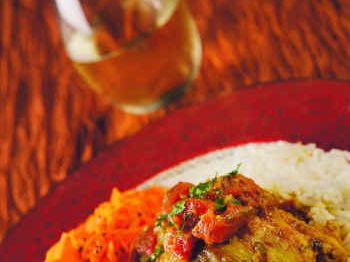
reference-image, l
(article, Anu Karwa)
p(blue). Editor's note: Anu Karwa wrote the Culinate wine column, titled Swirl, from July 2009 through December 2010. "I've heard of how to pair meat and fish (red with meat, white with fish), but what about when I'm cooking something different, like Indian food?" Everyone knows the old rule of pairing meat with red wine and fish with white wine. Not only is this rule being challenged daily, but it also doesn't even remotely cover the wide of range of cuisines we cook and eat nowadays. So what should you pair with something like Indian food, with its complex mix of spices and sauces? As with most meals, the right wine can elevate your meal. But the complexity of flavors — spicy, sweet, salty — and layering of flavors in an Indian dish makes food and wine pairing challenging. It's certainly not impossible, however, if you follow a few guidelines. [%image indianfoodandwine float=right width=300 caption="Don't be afraid to serve wine with Indian food."] Fiery dishes beg for a wine to balance the heat, not add to it. You also want to stay away from anything too high in alcohol, because it intensifies the spice. Avoid highly tannic wines (like a bold Barolo or a heavy Cabernet Sauvignon), which can add a bitter taste to highly flavorful, pungent dishes. For spicy vegetable dishes, my go-to recommendation is a Gewürztraminer from Germany. Its lychee and rose aromas hint at a sweetness that makes it a natural fit. Another great pairing is a Kabinett-style Riesling from Germany. The slightest off-dry taste and racy acidity really works. Other options for searing-hot dishes slightly heavier in texture include a Muscadet from the Loire Valley in France or, for the more adventurous wine drinker, the up-and-coming white varietal of Torrontes from Argentina. It has a gorgeous, aromatic nose, but doesn’t have a ton of complexity that would be lost with a more subtle dish. A Pinot Gris from Oregon also makes a nice choice. If you have a salty or fried dish, cut through it with a highly acidic white wine also based on Sauvignon Blanc grapes, such as a Pouilly-Fumé or Sancerre. White wines aren’t the only choices for Indian meals. Meaty, gamey dishes like lamb that have intense, heavier flavors including chile and garlic sauces or smokiness can stand up to red where crisp, delicate white wines would falter. One of the least known but most worthy picks is a Chinon, a light-bodied, savory, earthy red wine composed of Cabernet Franc grapes with distinct violet aromas from the Loire Valley of France. Another great option is a Burgundian-style Pinot Noir from Willamette Valley, Oregon, or Central Otago, New Zealand. Smokier flavors are complemented by medium-bodied spicy, flinty Shiraz. On the more adventurous side, try a Valpolicella from Italy or a slightly chilled Beaujolais Cru from France; both are perfect with pork dishes. When in doubt, you can’t go wrong pairing Indian food with Champagne, whose effervescence steadily matches the multilayered flavors present in most Indian dishes. The high/low combination of Champagne and Indian street food makes for a hip party theme whose sense of kitsch won’t be lost on fashionable friends.

reference-image, l

indianfoodandwine, l